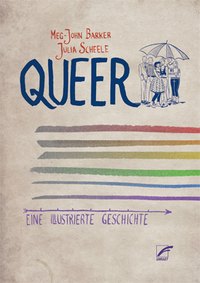You need to sign in or sign up before continuing.
Take a photo of a barcode or cover
1.06k reviews for:
Queer: Eine illustrierte Geschichte
Jennifer Sophia Theodor, Meg-John Barker, Julia Scheele
1.06k reviews for:
Queer: Eine illustrierte Geschichte
Jennifer Sophia Theodor, Meg-John Barker, Julia Scheele
i don’t think i comprehended like half of this, it was a lot to take in but was a very fascinating intro to queer theory! definitely recommend
I learned a lot, and appreciated that it was basically an entire semester in one graphic novel. However the almost complete ignoring of asexuality was unfortunate choice on the part of the author.
if you've never studied queer theory before this book might be a bit overwhelming but i think i knew just enough (but not too much) for this book to be well-suited to me: i knew a lot of the basics and a lot of the first half of this book was stuff i already knew (which was reassuring for me that i actually had taken in stuff from my studies lol whilst also helping clarify some of the more confusing stuff) and then the second stuff was mostly completely new. a really good read that explained things in a v accessible way and has given me lots of stuff to look into more
I thought this book was a fantastic intro to queer theory. Recommended.
For a book that spends a significant amount of time discussing and debating identity politics and acknowledging how queer theory has historically failed to acknowledge if not out right erased the work and perspectives of Black queers, they never mentioned the Combahee River Collective, the Black socialist lesbians who coined the term, or acknowledged how it’s been twisted in the decades since.
A really lucid introduction - easy to read, and broad enough that it will almost certainly introduce new concepts to anyone reading who hasn't read a summary of queer theory before. The illustrations are well put together, providing a little context, humour or just trying to reinforce the salient points visually.
Couldn't really ask for a better, approachable introduction to this extremely valuable area of theory.
Couldn't really ask for a better, approachable introduction to this extremely valuable area of theory.
Graphic novels are an incredibly accessible way to write really in other contexts would be a textbook. The book is information dense, but concise. I learned many philosophies I had only brushed upon before, and it really open my eyes in new approaches to consuming culture.
I would definitely recommend this book for those who are liberal thinking but struggle with some of the aspects of queer activism.
It's important if someone is feeling skeptical of some of the information to read the entire thing. Many of the criticisms and discussion are saved for the last pages, so I hope most people would remind themselves to engage with critical thought after getting through the whole so that they are better equipped for the conversation.
I would definitely recommend this book for those who are liberal thinking but struggle with some of the aspects of queer activism.
It's important if someone is feeling skeptical of some of the information to read the entire thing. Many of the criticisms and discussion are saved for the last pages, so I hope most people would remind themselves to engage with critical thought after getting through the whole so that they are better equipped for the conversation.
Full review on my blog 25th March 2022: https://inkandplasma.com/2022/03/25/queer-a-graphic-history/
I think it’s fair to say that this isn’t really a graphic novel of Queer History which, rightly or wrongly, is the assumption I made. Instead I’d call this an illustrated introduction to Queer Theory. That’s not necessarily a criticism, just not what I personally was expecting when I picked up this book. Putting that aside, though, I found several aspects of this book interesting and useful.
Personally I had some, but not extensive, experience with queer theory already. This meant that some of the concepts in this book were already very familiar to me, and those I didn’t particularly learn anything new from. On the other hand, other concepts that were unfamiliar to me were laid out in a very accessible way. To me this very much felt like a primer on queer theory. The cartoons and illustrations made it very accessible but, by their nature, created a more surface-level exploration of each topic. I think that this book will be an excellent read for anyone interested in learning about queer theory who isn’t quite sure where to start.
It begins by outlaying historical viewpoints and how they developed through time, and explains terminology clearly and succinctly. It’s a shame that there’s not a table of contents or a glossary, as I think I would be more likely to come back to this book as a jumping off point for further research, finding pages that interest me and using them to find other, more in-depth, texts on those particular subjects. Because each topic is restricted to a paragraph on each page, there isn’t a lot of depth to look at criticisms and support for each, and I think that for someone interested in queer theory they would have to research further to develop a real understanding. However, it does make it incredibly accessible for those who don’t know where to start without jumping straight into an overwhelming academic text.
I do think there were moments where the lack of depth did the book a disservice in the later sections of the book, particularly in the very complicated issues of queer theory criticisms. The surface level analysis of different texts, limited by the word count of the format, meant that there were moments where I felt like I was only being presented half of an analysis, and as someone which experience with queer theory, these moments could be frustrating. Some of these debates need that extra focus time and didn’t receive it.
I think it’s fair to say that this isn’t really a graphic novel of Queer History which, rightly or wrongly, is the assumption I made. Instead I’d call this an illustrated introduction to Queer Theory. That’s not necessarily a criticism, just not what I personally was expecting when I picked up this book. Putting that aside, though, I found several aspects of this book interesting and useful.
Personally I had some, but not extensive, experience with queer theory already. This meant that some of the concepts in this book were already very familiar to me, and those I didn’t particularly learn anything new from. On the other hand, other concepts that were unfamiliar to me were laid out in a very accessible way. To me this very much felt like a primer on queer theory. The cartoons and illustrations made it very accessible but, by their nature, created a more surface-level exploration of each topic. I think that this book will be an excellent read for anyone interested in learning about queer theory who isn’t quite sure where to start.
It begins by outlaying historical viewpoints and how they developed through time, and explains terminology clearly and succinctly. It’s a shame that there’s not a table of contents or a glossary, as I think I would be more likely to come back to this book as a jumping off point for further research, finding pages that interest me and using them to find other, more in-depth, texts on those particular subjects. Because each topic is restricted to a paragraph on each page, there isn’t a lot of depth to look at criticisms and support for each, and I think that for someone interested in queer theory they would have to research further to develop a real understanding. However, it does make it incredibly accessible for those who don’t know where to start without jumping straight into an overwhelming academic text.
I do think there were moments where the lack of depth did the book a disservice in the later sections of the book, particularly in the very complicated issues of queer theory criticisms. The surface level analysis of different texts, limited by the word count of the format, meant that there were moments where I felt like I was only being presented half of an analysis, and as someone which experience with queer theory, these moments could be frustrating. Some of these debates need that extra focus time and didn’t receive it.
Easy to read. I liked seeing how some concepts or phrases that I knew fit into a bigger picture, like a chronological development of ideas stemming from disagreements. An illuminating introduction
fast-paced





